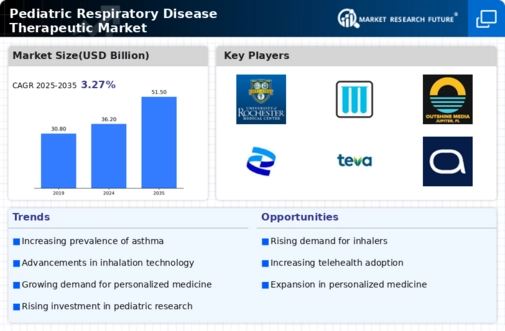Increased Awareness and Education
There is a growing awareness regarding pediatric respiratory diseases, which serves as a catalyst for the Pediatric Respiratory Disease Therapeutic Market. Educational initiatives aimed at parents, caregivers, and healthcare providers are helping to identify symptoms and promote early intervention. This heightened awareness is leading to increased diagnosis rates and, consequently, a greater demand for therapeutic options. According to recent surveys, nearly 60% of parents report being more informed about asthma management than they were five years ago. This shift in knowledge is likely to result in more children receiving appropriate treatment, thereby expanding the market for pediatric respiratory therapeutics as healthcare systems adapt to meet this rising demand.
Advancements in Medical Technology
Technological advancements in medical devices and treatment methodologies are significantly influencing the Pediatric Respiratory Disease Therapeutic Market. Innovations such as nebulizers, inhalers, and monitoring devices have improved the management of respiratory conditions in children. For instance, the introduction of smart inhalers equipped with digital tracking capabilities allows for better adherence to treatment regimens. Furthermore, the development of biologics and novel drug delivery systems enhances the efficacy of existing therapies. As these technologies continue to evolve, they are expected to drive market growth by providing healthcare professionals with more effective tools to manage pediatric respiratory diseases, ultimately improving patient outcomes.
Growing Investment in Pediatric Healthcare
Investment in pediatric healthcare is on the rise, which is a significant driver for the Pediatric Respiratory Disease Therapeutic Market. Governments and private sectors are increasingly allocating funds to improve healthcare services for children, including the treatment of respiratory diseases. This trend is evident in various initiatives aimed at enhancing healthcare infrastructure and access to specialized care. For instance, funding for pediatric hospitals and clinics has seen a notable increase, allowing for better diagnostic and therapeutic services. As investment continues to grow, it is expected that the market for pediatric respiratory disease therapeutics will expand, providing more resources for research, development, and patient care.
Regulatory Support for Pediatric Drug Development
Regulatory bodies are increasingly recognizing the need for pediatric-specific therapies, which is positively impacting the Pediatric Respiratory Disease Therapeutic Market. Initiatives such as the Pediatric Research Equity Act encourage pharmaceutical companies to conduct research focused on pediatric populations. This regulatory support is fostering an environment conducive to the development of new treatments tailored for children. As a result, more companies are likely to invest in pediatric respiratory disease therapeutics, leading to a broader range of available options. The emphasis on pediatric drug development not only addresses the unique needs of children but also enhances the overall market landscape by ensuring that effective therapies are accessible.
Rising Incidence of Pediatric Respiratory Diseases
The increasing prevalence of pediatric respiratory diseases is a primary driver for the Pediatric Respiratory Disease Therapeutic Market. Conditions such as asthma, bronchitis, and pneumonia are becoming more common among children, with studies indicating that asthma affects approximately 10% of children worldwide. This rise in incidence necessitates the development and availability of effective therapeutic options. As healthcare providers seek to address these growing concerns, the demand for innovative treatments and management strategies is likely to escalate. Consequently, pharmaceutical companies are investing in research and development to create targeted therapies that cater specifically to the pediatric population, thereby expanding the market for pediatric respiratory disease therapeutics.


















Leave a Comment